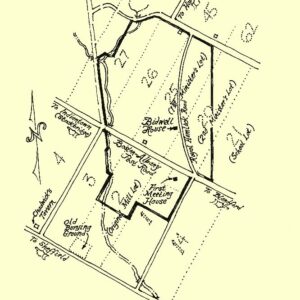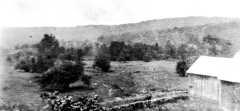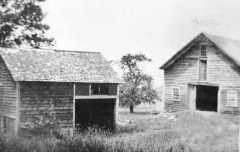History
The History of the Bidwell House
You can learn even more about Adonijah Bidwell, his family, the property, and local history through our Bidwell Lore blog series.
Built circa 1760 for the first minister of Township No. 1, the Reverend Adonijah Bidwell (1716-1784), the Bidwell House is a gracious two-story post-and-beam Georgian saltbox. Rev. Bidwell arrived in 1750 to be the first minister of this frontier region, which eventually became the towns of Monterey and Tyringham. After living in a home, no longer extant, elsewhere on the property, Bidwell built an imposing residence in the 1760s, with six large, paneled rooms, four fireplaces, two beehive ovens, and three closets.
His 1784 probate inventory, which is preserved and displayed in the museum, tells of a well-furnished house for the time and location. He owned a significant collection of pewter, three high chests, six beds, numerous chests and tables, a large library, and an amazing 48 chairs! Perhaps his large furniture collection came as a result of his three wives, as women often brought furniture as part of their dowry.
The high rate of mortality for women meant that more than one wife was common and indeed this was the case for Rev. Bidwell. Once his first house was completed (which was located elsewhere on the property) and he was settled into his position, Rev. Bidwell married his first wife, Theodosia Colton (1721-1759), in 1752. She was the daughter of his tutor at Yale College, Rev. Benjamin Colton (1690-1759). Known to be a poet, Theodosia’s work is unfortunately lost.
Theodosia died childless of an unknown cause in 1759. One year later, Rev. Bidwell married Theodosia’s first cousin, Jemima Devotion (1727-1771), also the daughter of a prominent Connecticut minister. It was around this time that the Bidwell House you see today was constructed. Jemima lived for ten short years as Mrs. Bidwell, bearing all of his children before she died: Adonijah, Jr. (1761-1837), Barbabas (1763-1833), Jemima (1765-1842), and Theodosia (1766-1841). Having young children to raise, Rev. Bidwell lost no time in marrying his third and final wife, Ruth Kent (1730-1815), in 1772. Not all women died young: Ruth lived to be a healthy 85.
The location of the house was the first town center of what was originally known as Housatonic Township No. 1. The Bidwell House was the parsonage, and the first meeting house, located at the crossroads of the Great Trail (the Boston-Albany Post Road) and Royal Hemlock Road, was a short walk from the house. The location of the meeting house and Rev. Bidwell’s first home can be found along the Meeting House Trail to the south of the property.
After Rev. Bidwell’s death in 1784, the settlement opted to build a new meeting house and parsonage a mile south-west of the original site. The first meeting house fell into disrepair and later burned down. The Bidwell House and property remained in the Bidwell family and was handed down from father to son to grandson, each generation adding to the architecture of the house.
Rev. Bidwell farmed the property from 1750 to 1784. His eldest son, Adonijah Bidwell Jr., developed the farm into a large and prosperous dairy farm, expanding the landholdings and building a compound of barns and out-buildings. His tenure was 1784-1836. The grandson, John Devotion Bidwell (1792-1867), continued to farm and also added a tanning yard.
However, the development of western farmlands, the railroad, and the Erie Canal all aided in the shift of farming to the West and the abandonment of New England farms. In 1853 the house and property were sold out of the family. Three generations of the Carrington family farmed the property until 1911, when it was sold to a logging company. In 1913 it was purchased, along with other land held by the logging company for a total of 408 acres, by Raymond P. Ensign, who established the Berkshire Summer School of the Arts on the property and operated that until 1936. Ensign sold 196 acres of this land to B. Britton Gottesberger in 1926, and he remained there seasonally until 1941. It was owned by the Conn family from 1941 to 1960, after which it was purchased by Jack Hargis and David Brush. During their time here, they set about furnishing the house according to Rev. Bidwell’s probate inventory, and upon their deaths, left it to become a historic house museum. The Bidwell House Museum opened for its first season in 1990.



